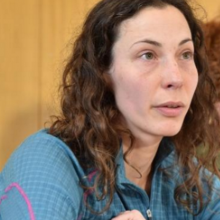
It is a saga of foolish mistakes, tragedy and resilience and courage. There are lessons about the dangers of the outdoors, the vulnerability of visitors, basic mountain safety and personal responsibility.
Ms Pizova accepts she and travelling companion Ondrej Petr made major mistakes. First, they underestimated winter conditions. The Routeburn, where Mr Petr lost his life, is a Great Walk and in good conditions is straight-forward. It is well-marked and signposted, and it is hard to imagine trampers becoming lost or getting into strife. In winter or in bad weather, however, the hazards mount.
Despite the highest point on the track, near Harris Saddle, being a mere 1300m in altitude (that must seem low to Europeans), it and the sidle towards Mackenzie Hut are exposed and potentially dangerous.
The pair also underestimated the way New Zealand weather can change so quickly, a threat at any time of the year. Visitors have gone into the back country on sunny days for a hike for a few hours without warm clothing or wet weather gear and been caught out. Fatalities have followed. In this instance, fog, rain and snow ruined visibility. The track and its markers were completely buried under snow. A trip between Falls Hut and Mackenzie Hut that should take only a few hours became a nightmare.
It would seem weather forecasts - so much more accurate than they once were - were ignored. For those seeking adventures in the hills, it can be a very long wait for perfect weather. Nevertheless, the best response when the prospect is for really bad conditions is to call off the tramp.
The pair lacked an emergency locator beacon. Carrying one might not have saved Mr Petr but it would have enabled prompt rescue for Ms Pizova. A beacon would hardly be necessary in peak season on a track like the Routeburn but in winter it would be advisable to own, borrow or rent one.
The pair also failed to leave specific intentions with anyone, breaking another tramping rule. It took concern posted on social media for the alarm to be raised.
Ms Pizova and Mr Petr ignored, as well, warnings not to go. Parties often go on to the Routeburn from both ends in winter. But around the bluffs at Lake Harris is rife with avalanche risk and should not normally be crossed. There are also other perilous parts after heavy snow.
It is definitely winter country for ice axes and crampons, and, after deep fresh snow, for snow shoes. It would seem, at least, the pair had reasonably warm clothes. Otherwise, Ms Pizova might not have survived three nights outdoors, two alone after Mr Petr died.
Both, it seems, were used to snow and even climbing, and Ms Pizova displayed extraordinary fortitude to find her way to the Lake Mackenzie warden's quarters where she broke a window and holed up for weeks. She made attempts to head out, including an endeavour to fashion snow shoes from branches. But, sensibly, she stayed put.
Too often in such circumstances observers look to blame Doc for insufficient warnings. But any research into New Zealand conditions illustrates the dangers and Doc signs warn about them, including signs along the Routeburn about the avalanches risks.
At the same time, Doc has to be careful not to become too risk averse. If its warnings are too commonplace and over-the-top they lose credibility. It becomes like ``the boy who cried wolf''. Notifications are not believed.
In any event, there is a certain level of danger in the mountains. That is part of the attraction and the challenge. Our sympathies go to Ms Pizova after the tragic end to the New Zealand adventure. But in the end, individuals have to take responsibility for their own decisions.











